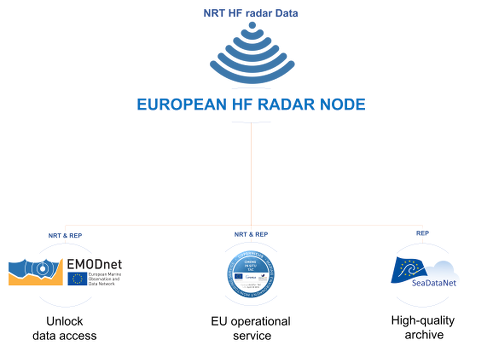
Short title:
Contribution of CNR to the European High Frequency Radar Node Competence Center for HF radar data management. The infrastructure offers services and tools for applying the European Common QC, Data and Metadata Model for NRT and DM HFR current data and for distributing HFR data towards CMEMS-INSTAC, EMODNet Physics and SeaDataNet portals.
Short title2: EU HFR NODE / CNR eInfrastructure
Link to website:
• EU HFR NODE Data Entry Webform
• Processing tools for HFR operators
Description:
The European High Frequency Radar Node (EU HFR Node) was established in 2018 by AZTI, CNR-ISMAR and SOCIB, under the coordination of the EuroGOOS HFR Task Team, as the focal point and operational asset in Europe for HFR data management and dissemination, also promoting networking between EU infrastructures and the Global HFR network. The EU HFR Node is fully operational since December 2018 in distributing tools and support for standardization to the HFR providers as well as standardized Near Real Time (NRT) and Delayed-Mode (DM) HFR radial and total current data to CMEMS-INSTAC, EMODnet Physics and SDC Data Access. The EU HFR Node is managing data from European HFR networks and integrates and delivers US HFR network data to the aforementioned data portals. In particular, the EU HFR Node implements the functions of data acquisition and harvesting, QC, validation/assessment, NRT data delivery and historical data distribution with different reprocessing levels.
The core of this service consists in the continuous development of the data model and the processing standards through discussion with operators, providers, distributors and international experts. Based on this, the EU HFR Node maintains and updates manuals, procedure guidelines and software tools, and pushes them towards the HFR operators, providers and managers via repositories and training workshops. In particular, the software tools for processing native HFR data for QC and converting them to the standard format for distribution are continuously made available to HFR operators via public GitHub repositories and releases with DOI assigned.
The data processing and distribution service is founded on a simple and very effective rule: if the data provider can set up the data flow according to the defined standards, the node only checks and distributes the datasets. If the data centre cannot set up the data flow, the EU HFR Node directly harvests the raw data from the provider, harmonizes, quality-controls and formats these data and makes them available to the marine portals. The strength and flexibility of this solution reside in the architecture of the European HFR node, which is based on a centralized database, fed and updated by the operators via a webform. The database contains updated metadata of the HFR networks and the needed information for processing/archiving the data.
The guidelines on how to set the data flow from HFR providers to the EU HFR Node are thoroughly described in DOI:10.25704/9XPF-76G7.
Institute:
Institute of Marine Sciences of the National Research Council of Italy (CNR-ISMAR)
Contact name: Lorenzo Corgnati, Carlo Mantovani
Contact email: Please login or register to view contact information.
Location: Global
Tags:
THREDDS, TDS, HF radar, netCDF, current, velocity, remote sensing, Best Practices, QA, QC, FAIR, standard, data model.
